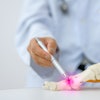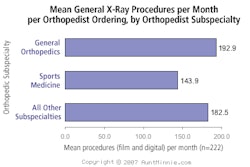
Since the introduction of digital x-ray more than 25 years ago, healthcare facilities and their patients have benefited from the numerous advantages that the technology affords. With the advantages of digital also come variations in x-ray exposure dose to patients, however. The variations can occur more readily and without knowledge of the technologists with the use of digital x-ray systems than film-screen systems. These variations have been and continue to be studied by researchers and manufacturers, who have implemented many preventive measures to provide exposure feedback to technologists.
For all digital x-ray systems, regardless of the detector type, the primary cause of exposure variation is the improved consistency of the digital image's appearance compared to film-screen imaging when under- or overexposed. This attribute unfortunately provides a lack of image appearance feedback to the technologist.
With CR, the wide latitude and linear response to x-ray energy provides an image appearance that remains consistent throughout exposure levels in this range. The extended margin of error is especially valuable when manual exposure techniques must be used, as is the case with portable exams.
For fixed-location digital x-ray systems, autoexposure controls provide consistency. The primary indication of a less-than-optimal dose in digital x-ray is the appearance of noise in underexposed images. To avoid this, technologists may inadvertently increase dose, leading to the phenomenon known as "dose creep."
This phenomenon has been studied in computed radiography (CR) systems. Dr. Matthew Freedman of Georgetown University in Washington, DC, and David Gur, Ph.D., of the University of Pittsburgh in Pennsylvania first reported it in 1993 independently. While the specific tools employed by manufacturers of CR systems may vary in name and specific function, the best vendors now routinely provide an array of tools to help their users avoid and manage this situation.
Heightened detector sensitivity can also overcome the tendency to increase dose. Advances such as dual-side reading of CR imaging plates and new cesium bromide (CsBr) detectors have allowed for thicker phosphor layers. Thicker phosphor layers increase the detectors' detective quantum efficiency (DQE), which routinely provides lower noise levels at standard doses. Thicker phosphors also afford comparable image quality to current systems at reduced exposures, or when a lower exposure is mistakenly applied. With these newer technologies, quantum noise appears less frequently in the image, also reducing the tendency to increase dose. In this regard, CR and digital radiography (DR) are similar.
Image processing
Digital image processing is another tool available to address dose creep. For specific clinical tasks, such as pediatric imaging, significant reductions in exposure dose may be needed. As stated previously, while images of lesser dose will still portray suitable anatomical density differences to be diagnostic, they may exhibit considerable noise. Digital noise reduction processing is now available from leading CR vendors to facilitate highly diagnostic, low-dose pediatric imaging. This same tool can be employed to improve images inadvertently acquired at less-than-optimal doses.
The availability of postprocessing tools provides technologists with assurance that a highly diagnostic image can be produced from a mistakenly low-exposure exam, which can overcome any tendency there may be to increase dose to "play it safe."
Vendors typically work with imaging facilities to optimize the image processing menus for digital x-ray systems, and establish dose levels to achieve clinically acceptable images for each exam type. Indices such as S value (Fujifilm Medical Systems USA, Stamford, CT) and Exposure Index (EI) (Eastman Kodak Health Group, Rochester, NY) can be used as a guideline for relative exposure intensity. Thus, if the x-ray generator, tube voltage, patient, processing menu, patient positioning, distance, and delay in processing time remain unchanged, the S value or EI can be used as a relative representation of the x-ray dose. Understanding the patient-absorbed dose in relationship to tube potential is key in determining the proper exposure factors. Leading digital x-ray vendors can provide technique guides that are targeted to comply with the ALARA (as low as reasonably achievable) principle.
Overall, the emphasis in clinical use of CR and DR has been reducing dose as much as possible. Most digital x-ray systems are delivered with a standard set of image processing options that have been fine-tuned by the manufactures to accelerate clinical acceptance of low-dose images. These processing options, along with the related support materials, auditing tools, and training provided by the vendor, are the key items to a deployment that adheres to the ALARA principle.
Successful implementation requires the participation of a cross-section of radiology professionals that typically includes technologists, radiologists, vendor applications specialists, and clinical physicists. Each examination is unique, and it is imperative that each facility establish dose limits for each view based on the clinical requirements of the examination. These values can then serve as the baseline for daily operations and ongoing quality control programs to ensure that they are maintained. Quality control testing software provided by most manufacturers provides maintenance metrics for the various components of the equipment and display. Also, appropriately trained staff is critical to facilitating oversight and monitoring of systems operation between scheduled evaluations.
Initial training for digital x-ray equipment typically includes basic application of the imaging software, image processing, and user interface instruction, but it is also geared toward observing image quality and the ALARA principle. Noise may be reduced and image quality improved with the use of grids, collimation, field size selection, and proper radiographic technique. Additional training, scheduled six months to a year after initial training, is beneficial to the user learning the nuances of digital x-ray. An imaging specialist reviews digital image acquisition basics and provides more advanced training about sophisticated features provided by the system. It is at this time that there is an opportunity to review image quality questions with the technologists and address any existing image quality concerns with the radiologist.
Periodic review of exposure indicators using vendor-specific programs developed for reject analysis can assist users in determining if exposures are within the desired range. To further aid users in monitoring exposures, a new software tool from one vendor provides alerts when exposures are recorded that fall outside of a particular exposure range or a specific value determined by the radiologist. When the exposure is higher or lower than the predetermined range for that particular exam, an alert and window will be displayed notifying the technologist and providing the choice to repeat the exam or continue the study and use the display warning as a caution for future like exposures.
In addition to the efforts by digital x-ray manufacturers, the American Association of Physicists in Medicine (AAPM) is also taking steps to improve awareness of the use of proper exposure factors during radiographic studies. The AAPM has appointed medical physicists Jeff Shepard and Jihong Wang, Ph.D., both of the M. D. Anderson Cancer Center in Houston, to co-chair a committee called Task Group No. 116 DR Exposure Index (TG116) to study recommended exposure indicators for digital radiography. The goal of this working group is to recommend standardized exposure reporting methods, making it easier for technologists to relate exposure feedback values from one manufacturer's digital x-ray device to another. The committee has invited corporate liaisons to attend meetings and offer suggestions. To date, more than eight digital x-ray system manufacturers have participated.
Digital x-ray imaging affords many benefits over film-based imaging, including the potential for significant reduction in patient radiation exposure. Digital x-ray is different from film-screen x-ray in many ways, and users have become cognizant of these differences. Steps have been taken to address these identified differences, and any limitations or cautions have been largely overcome.
Regardless of the acquisition medium -- film, CR, or DR -- good radiographic practices are essential to optimize image quality and maintain appropriate exposure levels. Dose creep has been recognized, well understood, and largely addressed through technology and a combined effort of the vendor and user communities, ensuring that patients imaged with digital x-ray receive the right dose, and that the highest-quality images are acquired for the best diagnosis and patient care.
By John Strauss, Kathy Pitura, George Spahn, Rick Schwind, and Dave MacCutcheon
AuntMinnie.com contributing writers
April 11, 2007
John Strauss, Kathy Pitura, George Spahn, Rick Schwind, and Dave MacCutcheon are employees of Fujifilm Medical Systems USA of Stamford, CT.
Related Reading
Study suggests ways to cut CR radiation, March 5, 2007
Korean rads find no edge for high-res CR in chest exams, January 22, 2007
Study: DR delivers lower radiation dose, November 7, 2006
U.S. hospitals find ways to take the digital x-ray plunge, October 12, 2006
Digital radiography slowly, but surely, makes its mark, July 25, 2006
Copyright © 2007 AuntMinnie.com



















